|
Discover the
hidden treasures of Drake Bay, Costa Rica with Tracie "The Bug Lady"

Home

Tour
Basics

Meet the Bug
Lady

Tales from the
Edge

Media

Reservations

Links



Facts about Drake Bay, Costa Rica

Travel To Drake Bay

Drake Bay Area Map

Hotel Information

Tips for Travelers

Tours

Recommended
Reading





|
|
|
There is probably no better ambassador for Costa Rica, and for
Tropical Rainforests in general, than the Gaudy Leaf Frog. Their
bold and vibrant color patterns make them one of the most
photographed frogs in the world.
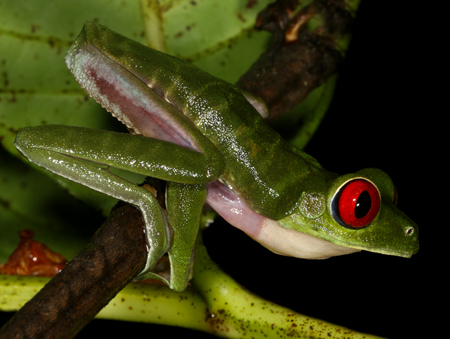 Along
with Toucans, Parrots, Monkeys and Quetzals, these very attractive
amphibians have come to embody the beauty and wonder awaiting
discovery in the Costa Rican Rainforest. There is hardly an item in
any souvenir store which is not decorated with its image: t-shirts,
beach towels, calendars, hats, stuffed animals, shot glasses or any
other item imaginable. Along
with Toucans, Parrots, Monkeys and Quetzals, these very attractive
amphibians have come to embody the beauty and wonder awaiting
discovery in the Costa Rican Rainforest. There is hardly an item in
any souvenir store which is not decorated with its image: t-shirts,
beach towels, calendars, hats, stuffed animals, shot glasses or any
other item imaginable.
Yet, the moment you see this frog in person,
the reason it fascinates observers and why it is such a sought after
model for photographers becomes strikingly obvious. It truly has a
charm all its own. |
|
Gaudy Leaf
Frogs are primarily lowland frogs and can be commonly found
throughout the Caribbean Lowlands and the humid lowlands of the
Pacific Slope from sea level to about 1000 meters in elevation.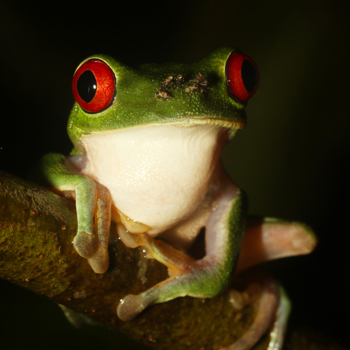 They are not found in the drier parts of the Guanacaste Province,
but have recently been collected on the southern most tip of the Nicoya
Peninsula. Their size ranges from 50 to 71 millimeters, females
being larger than males.
They are not found in the drier parts of the Guanacaste Province,
but have recently been collected on the southern most tip of the Nicoya
Peninsula. Their size ranges from 50 to 71 millimeters, females
being larger than males.
There are two distinct, geographically isolated, populations in
Costa Rica. Although they are still considered the same species,
frogs living on the Caribbean side have much brighter coloration.
These individuals normally have bright orange hands and feet as well
as bright blue along their sides. Their upper arms are normally
either bright blue or orange. The intensity of the colors and their
pattern make these Caribbean frogs truly gaudy specimens.
|
|
The coloration of Gaudy Leaf Frogs in Drake Bay, and throughout the
Pacific Slope, is a bit muted. Their fingers and toes may have
greenish, cream or light orange coloration and their sides are
normally a much lighter blue or brownish in color.
 Still,
they remain a spectacle to behold and invariably bring a gasp and a
smile to everyone's face when encountered on The Night Tour. All of
the frogs featured on this web page are wild individuals
photographed in Drake Bay. Still,
they remain a spectacle to behold and invariably bring a gasp and a
smile to everyone's face when encountered on The Night Tour. All of
the frogs featured on this web page are wild individuals
photographed in Drake Bay.
Because of their arboreal
and nocturnal lifestyle, Gaudy Leaf Frogs are not so easily
encountered by travelers. During dry season, as well as throughout
the day, they all but disappear into the forest canopy. Very
little is known about their activity during these times. On the
Pacific, because there is a pronounced dry season, we only tend to
see them during the rainier months. Breeding season normally begins
in late May or early June and this is when males descend closer to
ground level and embark on their quest to find a mate.
Activity usually peaks on
rainy nights, sometimes before or after a heavy rain. Generally
males will call in groups near a breeding site. Calling males will
try different perches, facing different directions throughout the
night in an effort to improve their chances of attracting a female.
A gravid female will sit and listen to the calling males until she
decides on one she likes. |
|

Their advertising call is
very
simple, usually a single "chuck" or sometimes a double "chuck,
chuck". Although their call is so simple, a female will decide on
her mate based solely on his call. Once she has decided on a mate
she will walk towards him in a straight line, passing by other
calling males on the way there.
On rare occasions, two males will fight over a female, as is pictured
on the left. One night, while walking near La Paloma Lodge,
we came upon this incredible battle scene. We watched in tense silence, awaiting
the outcome. During this match, the two males wrestled for several
minutes until one was dislodged from the perch and retreated
unharmed. The
larger female observed the events develop from a branch a couple of feet
above the battleground.
|
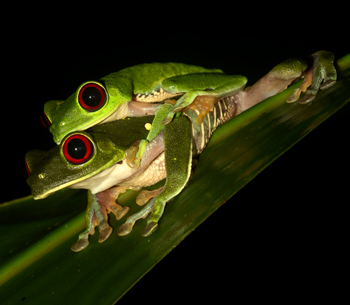 Once the female finally reaches
her chosen male, she
will turn around and he will mount her in axillary amplexus. This is
when the male climbs onto the female's back and grips her near
the armpits. In some cases, intrepid rival males will attempt to
dislodge the already mounted male. Sometimes the intruder will
even lodge himself on the female's back along with her preferred
mate and will also fertilize the egg clutch! In these cases,
studies have shown that the two male's DNA will fertilize
different individual eggs inside the egg clutch. Once the female finally reaches
her chosen male, she
will turn around and he will mount her in axillary amplexus. This is
when the male climbs onto the female's back and grips her near
the armpits. In some cases, intrepid rival males will attempt to
dislodge the already mounted male. Sometimes the intruder will
even lodge himself on the female's back along with her preferred
mate and will also fertilize the egg clutch! In these cases,
studies have shown that the two male's DNA will fertilize
different individual eggs inside the egg clutch.
|
|
|
Once in amplexus, the female
will descend to a body of water, carrying her mate on her back, and
fill her bladder by absorbing
water through her skin. She will then climb back
into the vegetation and pick a spot that is suitable for her egg
clutch. This is normally on the upper or lower side of a leaf. Egg
clutches may contain anywhere from 11 to 104 eggs and will be
fertilized by the male as she lays them. After the eggs are laid,
she will empty her bladder on them, making them swell as they absorb
the water. She may go through this process as many as five times in
a single night and lay up to 265 eggs.
The eggs are transparent and
the little embryos can be observed as they grow. As they develop,
they will take on a darker brown color and frequently move around
inside their egg. They will finish their development in about five
to seven days. |
|
Normally, during a heavy
rain, the little tadpoles will wiggle free of the egg mass and will
hopefully find their way into a temporary pool where they will
complete their metamorphosis.

By laying their eggs on leaves and completing their tadpole stage in
temporary pools,
rather than rivers or streams, Gaudy Leaf Frogs bypass the predators
responsible for the highest egg and tadpole mortality: fish. Still,
their eggs are preyed upon by Northern Cat-eyed Snakes (Leptodeira
septentrionalis) and Yellow Chunk-headed Snakes (Imantodes
inornatus). Northern Cat-eyed Snakes, which are frog
specialists, will also prey on adult frogs. |
|
After
the tadpoles leave the egg mass and reach a temporary pool they will
complete metamorphosis in about 80 days. Because their development
takes place in temporary pools, tadpoles are quite resistant to
dehydration and may live up to 20 hours out of the water.
 This way,
if their puddle dries up, they may be able to survive until the next
heavy rain refills it. This way,
if their puddle dries up, they may be able to survive until the next
heavy rain refills it.
Once the
little frogs leave the water, it will take them about a year to
reach adult size. Very little is know about the activities and
behavior of juvenile frogs.
Gaudy Leaf
Frogs can change their skin color and typically have their day time
and night time colors. They
have a light green color during the day and while they are at rest.
After they become active at night, their skin normally turns a
darker shade of green.
Like
most frogs, Gaudy Leaf Frogs posses skin toxins. Frogs belonging to
the Phyllomedusine Subfamily, as Gaudy Leaf Frogs do, have a very
unique blend of toxins including two substances not found on the
skin of any other amphibian on earth. Although they are not nearly
as irritating as many other Costa Rican frogs, special care should
always be taken when handling them. There
are some frog species that should never be handled by anyone besides
trained professionals. |
|
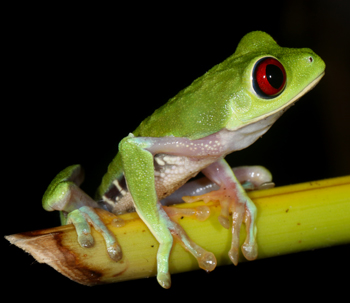 A frog collector in Costa Rica handled several Gaudy Leaf Frogs and
later smoked a cigarette without washing his hands. The toxins
passed on to his cigarette and he then inhaled them. This resulted
in coughing fits and a general discomfort that lasted for an entire
day. When handling any frog, it is always important to wash your
hands before and afterwards. Washing them before will protect the
frog from absorbing any substances that you may have on you hands.
Washing them afterwards will protect you from the toxins present on
the frog's skin. Even after washing your hands, it is a good idea to
refrain from touching your mouth, eyes and nose. Small frogs should
be handled sparingly, since just your body heat may be enough to
make it overheat and kill it. A frog collector in Costa Rica handled several Gaudy Leaf Frogs and
later smoked a cigarette without washing his hands. The toxins
passed on to his cigarette and he then inhaled them. This resulted
in coughing fits and a general discomfort that lasted for an entire
day. When handling any frog, it is always important to wash your
hands before and afterwards. Washing them before will protect the
frog from absorbing any substances that you may have on you hands.
Washing them afterwards will protect you from the toxins present on
the frog's skin. Even after washing your hands, it is a good idea to
refrain from touching your mouth, eyes and nose. Small frogs should
be handled sparingly, since just your body heat may be enough to
make it overheat and kill it.
|
|
References:
Beletsky, L.
2005 Travellers' Wildlife Guides Costa Rica
Interlink Publishing
Kubicki, B. 2004 Leaf-frogs of Costa Rica
Editorial INBio
Leenders, T.
2001 A Guide to Amphibians and Reptiles of Costa Rica
Zona Tropical
Savage, J. 2002 The Amphibians and Reptiles of
Costa Rica University of Chicago Press
|

|
|
|
|
The Frog
Files





     






 |
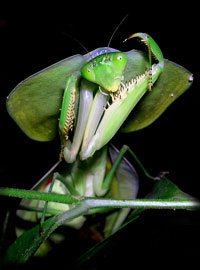


 Alien Earthlings
Alien Earthlings  The
Dark Side
The
Dark Side





 Along
with Toucans, Parrots, Monkeys and Quetzals, these very attractive
amphibians have come to embody the beauty and wonder awaiting
discovery in the Costa Rican Rainforest. There is hardly an item in
any souvenir store which is not decorated with its image: t-shirts,
beach towels, calendars, hats, stuffed animals, shot glasses or any
other item imaginable.
Along
with Toucans, Parrots, Monkeys and Quetzals, these very attractive
amphibians have come to embody the beauty and wonder awaiting
discovery in the Costa Rican Rainforest. There is hardly an item in
any souvenir store which is not decorated with its image: t-shirts,
beach towels, calendars, hats, stuffed animals, shot glasses or any
other item imaginable.
 They are not found in the drier parts of the Guanacaste Province,
but have recently been collected on the southern most tip of the Nicoya
Peninsula. Their size ranges from 50 to 71 millimeters, females
being larger than males.
They are not found in the drier parts of the Guanacaste Province,
but have recently been collected on the southern most tip of the Nicoya
Peninsula. Their size ranges from 50 to 71 millimeters, females
being larger than males. Still,
they remain a spectacle to behold and invariably bring a gasp and a
smile to everyone's face when encountered on The Night Tour. All of
the frogs featured on this web page are wild individuals
photographed in Drake Bay.
Still,
they remain a spectacle to behold and invariably bring a gasp and a
smile to everyone's face when encountered on The Night Tour. All of
the frogs featured on this web page are wild individuals
photographed in Drake Bay.

 Once the female finally reaches
her chosen male, she
will turn around and he will mount her in axillary amplexus. This is
when the male climbs onto the female's back and grips her near
the armpits. In some cases, intrepid rival males will attempt to
dislodge the already mounted male. Sometimes the intruder will
even lodge himself on the female's back along with her preferred
mate and will also fertilize the egg clutch! In these cases,
studies have shown that the two male's DNA will fertilize
different individual eggs inside the egg clutch.
Once the female finally reaches
her chosen male, she
will turn around and he will mount her in axillary amplexus. This is
when the male climbs onto the female's back and grips her near
the armpits. In some cases, intrepid rival males will attempt to
dislodge the already mounted male. Sometimes the intruder will
even lodge himself on the female's back along with her preferred
mate and will also fertilize the egg clutch! In these cases,
studies have shown that the two male's DNA will fertilize
different individual eggs inside the egg clutch.


 This way,
if their puddle dries up, they may be able to survive until the next
heavy rain refills it.
This way,
if their puddle dries up, they may be able to survive until the next
heavy rain refills it.  A frog collector in Costa Rica handled several Gaudy Leaf Frogs and
later smoked a cigarette without washing his hands. The toxins
passed on to his cigarette and he then inhaled them. This resulted
in coughing fits and a general discomfort that lasted for an entire
day. When handling any frog, it is always important to wash your
hands before and afterwards. Washing them before will protect the
frog from absorbing any substances that you may have on you hands.
Washing them afterwards will protect you from the toxins present on
the frog's skin. Even after washing your hands, it is a good idea to
refrain from touching your mouth, eyes and nose. Small frogs should
be handled sparingly, since just your body heat may be enough to
make it overheat and kill it.
A frog collector in Costa Rica handled several Gaudy Leaf Frogs and
later smoked a cigarette without washing his hands. The toxins
passed on to his cigarette and he then inhaled them. This resulted
in coughing fits and a general discomfort that lasted for an entire
day. When handling any frog, it is always important to wash your
hands before and afterwards. Washing them before will protect the
frog from absorbing any substances that you may have on you hands.
Washing them afterwards will protect you from the toxins present on
the frog's skin. Even after washing your hands, it is a good idea to
refrain from touching your mouth, eyes and nose. Small frogs should
be handled sparingly, since just your body heat may be enough to
make it overheat and kill it. 






